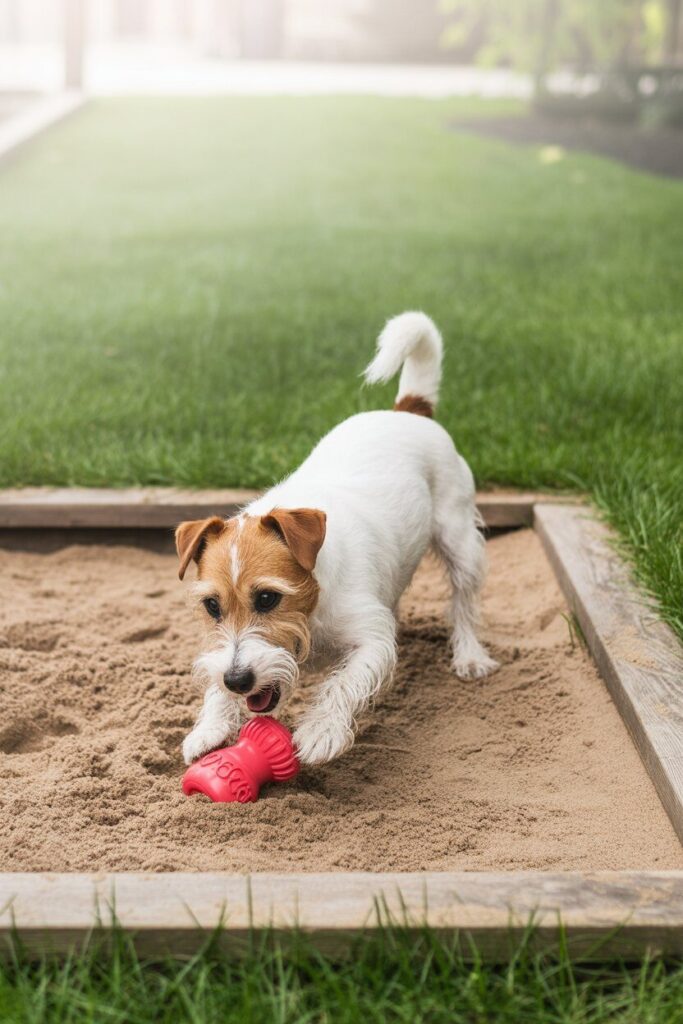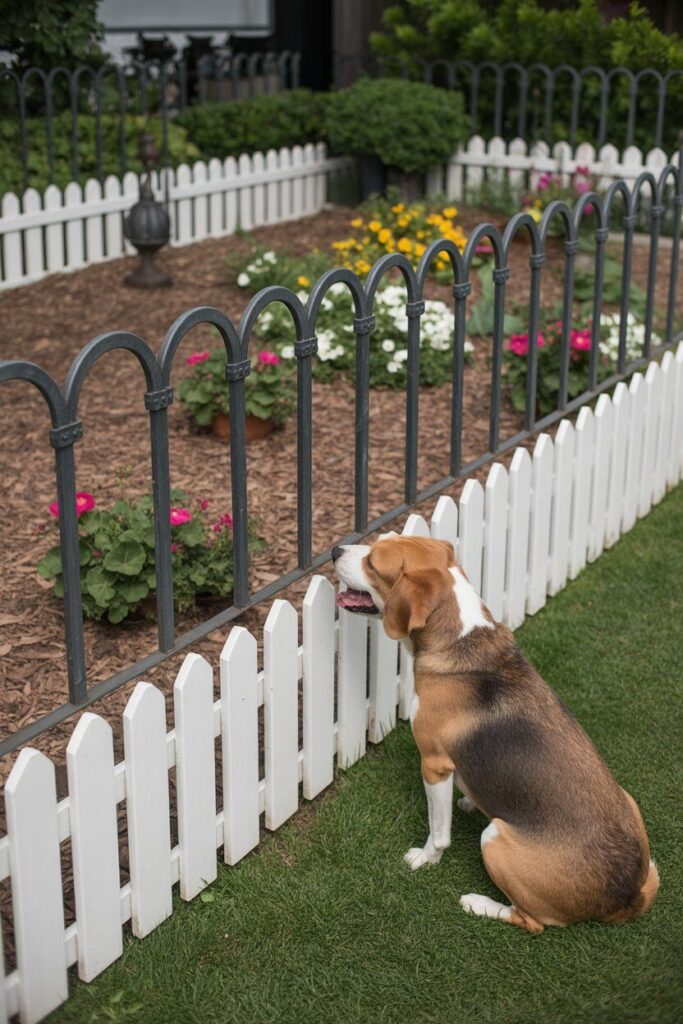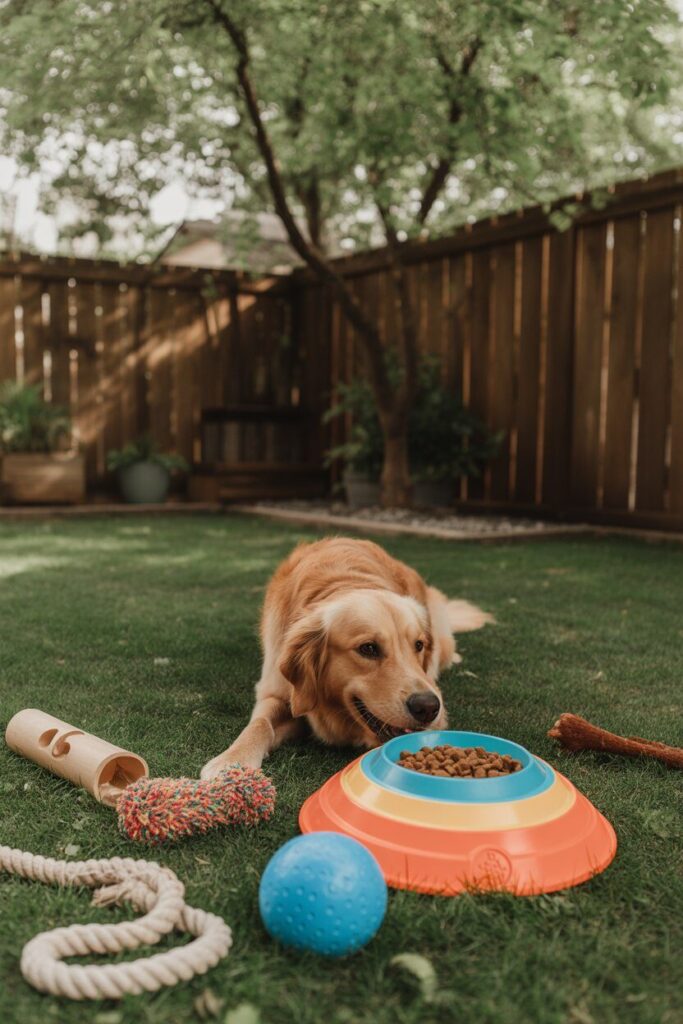Is your dog turning your backyard into a construction zone? I get it. One day, you have grass; the next, it looks like an archaeological site.
Dogs dig—it’s in their nature. But when those holes multiply, it can be really frustrating.
The good news is you can stop your dog from digging with simple training. It’s not rocket science. You just need patience, consistency, and a few clever tricks.
And yes, you can do it without treating your dog like a boot camp recruit.
Why Do Dogs Even Dig?
Before you start fixing the problem, you’ve got to understand why your pup digs in the first place. Dogs never do things “just because,” even if it looks that way.
Common Reasons for Digging
- Boredom: A bored dog will look for entertainment, and digging can feel like doggy Netflix.
- Hunting Instincts: Some breeds, especially terriers, were literally bred to dig out prey.
- Cooling Down: On hot days, dirt is cooler than grass. Your dog might dig to chill out.
- Attention-Seeking: If every time they dig you rush over, congratulations, they’ve trained you.
- Escape Plans: Some dogs dig near fences because they’re determined to see what’s on the other side.
Think about your dog’s habits. Does the digging happen at certain times? In specific spots? The “why” tells you what solution will actually work.
Step One: Burn Off That Extra Energy

Ever noticed how kids get cranky when they’re restless? Dogs are the same. Most of the time, a tired dog won’t dig.
What to Do
- Daily Walks: Not a quick trip to the mailbox, but a solid 30–60 minutes.
- Playtime: Fetch, tug-of-war, or frisbee can drain a lot of energy.
- Training Games: Teach commands like “sit,” “stay,” or “roll over.” It’s fun and mentally tiring.
When I started upping my dog’s walks, the digging reduced almost instantly. It’s wild how much behavior changes when you simply burn off their zoomies.
Check out these top-rated training tools available on Amazon
Step Two: Give Them a Legal Digging Spot

Here’s the thing: dogs dig because they enjoy it. Instead of fighting nature, why not redirect it?
How to Set Up a Digging Zone
- Pick a Spot: Choose a corner of the yard where a few holes won’t ruin your landscaping.
- Make it Fun: Bury toys or treats there to encourage digging in the right place.
- Be Consistent: Every time they start digging elsewhere, gently guide them to the digging zone.
It might take a week or two, but most dogs catch on. And honestly, watching your dog go to town in their “approved” spot feels like a win-win.
Step Three: Block Off Forbidden Zones

Some areas are off-limits. Garden beds? No-go. Under the fence? Double no-go. You can’t exactly sit outside 24/7 playing referee, so the trick is to make those spots unappealing.
Smart Tricks That Work
- Chicken Wire: Lay it just under the soil. Dogs hate scratching against it.
- Rocks: Place big ones in favorite digging spots. It ruins the fun for them.
- Citrus Peels: Many dogs dislike the smell. Scatter orange or lemon peels around.
I once had a dog who thought my flower bed was her personal spa. A little buried chicken wire ended that hobby in record time.
Shop the best dog training picks today on Amazon
Step Four: Use Commands and Consistency
Training your dog to stop digging isn’t about yelling “No!” every time. It’s about consistent commands and redirection.
Training Tips
- Introduce a Command: Use “Leave it” or “No dig” every single time.
- Redirect: Immediately lead them to toys, play, or the digging zone.
- Reward: Praise or treat them when they make the right choice.
Consistency is the secret sauce here. Dogs don’t learn overnight, but if you stick with it, they connect the dots.
Step Five: Tackle the Root Cause
Remember those “whys” from earlier? Let’s dig (pun intended) into how to solve them.
Boredom
Solution: More walks, puzzle toys, interactive play. A tired brain and body mean fewer holes.
Hunting Instincts
Solution: Don’t leave your dog outside unsupervised if critters hang around. Try humane pest control to remove the temptation.
Cooling Off
Solution: Provide a shaded area or even a small kiddie pool. My dog loves her pool, and it saved my yard.
Attention-Seeking
Solution: Don’t reward digging with your attention. Instead, praise them when they’re calm and ignoring the dirt.
Escape Attempts
Solution: Reinforce fences, place deterrents along the base, or use landscaping to block digging zones.
When you address the specific reason, you’ll notice the problem shrinking much faster.
Discover helpful products for stopping digging directly on Amazon
Step Six: Keep the Yard Engaging

Here’s something people forget: your yard should be interesting to your dog. If it’s boring, the dirt becomes the entertainment.
Ideas to Spice Things Up
- Add a sandbox just for digging.
- Rotate toys outside so they feel “new.”
- Create little obstacle courses with tunnels or ramps.
Think of your yard as your dog’s personal playground. If it’s fun enough, the ground loses its appeal.
Step Seven: Don’t Forget Mental Stimulation

Physical activity is important, but mental workouts tire dogs out even more. A mentally satisfied dog won’t go looking for trouble.
Easy Brain Games
- Snuffle Mats: Hide kibble or treats in them.
- Hide and Seek: Let them find you or a favorite toy.
- Food Puzzles: Make mealtime a challenge instead of a dump-and-eat session.
I swear, five minutes of a food puzzle wears my dog out like a 20-minute walk. It’s pure magic.
Step Eight: Professional Help When Needed
Let’s be real: some dogs just don’t quit. If your pup keeps digging despite your efforts, it might be time for backup.
- Dog Trainers: They can help with stubborn habits and give you tailored advice.
- Veterinarians: Sometimes digging is linked to stress or medical issues. Always good to rule that out.
Don’t feel bad if you need extra help. Every dog is different, and sometimes a pro can spot something we miss.
What Not To Do
Quick PSA: some “solutions” you’ll find online are downright cruel. Avoid anything that causes fear or pain. Dogs don’t dig to annoy you; they’re just being dogs.
Things to Avoid
- Shock Collars: Overkill and unfair for a natural behavior.
- Harsh Punishment: Yelling or hitting only makes your dog anxious.
- Filling Holes With Dangerous Substances: Don’t even think about it.
Positive reinforcement works way better. Plus, it keeps your bond with your dog strong.
My Personal Take
When my dog went through her digging phase, I felt like I was losing the battle. But once I combined exercise, a designated digging spot, and consistent training, things turned around.
She still digs occasionally—but only where she’s supposed to. And honestly, watching her dig up a toy I buried is pretty adorable.
Training your dog isn’t about perfection. It’s about progress. Even small wins add up, and one day you realize you’ve reclaimed your backyard.
Conclusion
Stopping your dog from digging holes doesn’t require magic or frustration, just easy training, patience, and smart redirection.
Figure out why they dig, give them outlets for their energy, block problem areas, and keep them mentally stimulated.
Remember, dogs aren’t being “bad” when they dig; they’re just doing what comes naturally. Your job is to guide that instinct in the right direction.
With time, you’ll trade a yard full of holes for a happy dog and a happy lawn. And honestly, isn’t that the dream?
Why does my dog keep digging holes even after training?
Dogs dig for many reasons, and training may not solve the issue. If your dog keeps digging, they might be bored, not getting enough exercise, or trying to cool off.
Even with consistent commands, digging can return if their needs aren’t met. It’s like giving a child rules but no toys—they’ll find ways to entertain themselves.
Another reason could be habit. If your dog has dug for months or years, breaking the cycle takes patience. Stay consistent and reinforce good behaviors.
Provide a legal digging zone or plenty of mental activities. With time and persistence, the digging should decrease.
Is digging a sign of a bigger problem?
Not always, but it can be. Digging is normal for dogs, especially those with hunting or working instincts. If your dog digs occasionally, there’s usually no need to worry.
They might just be having fun, burning energy, or trying to cool down in the dirt.
However, excessive digging can signal anxiety, stress, or a medical issue. For instance, if a dog suddenly digs under doors or floors, it may show signs of separation anxiety.
If this behavior seems extreme or unusual, consult a vet or trainer to rule out any serious problems.
Will neutering or spaying stop my dog from digging?
In most cases, neutering or spaying won’t magically stop digging. This behavior often comes from energy, instincts, or boredom, not hormones.
While spaying or neutering can calm some hyperactivity and reduce roaming, it won’t guarantee to stop your dog’s digging.
If your dog digs near fences to escape, neutering or spaying might help reduce that urge. So, it won’t completely stop digging, but it could lessen escape-driven digging.
The real solution lies in training, redirection, and ensuring your pup is both physically and mentally satisfied.
How long does it take to train a dog to stop digging?
There’s no simple answer. Some dogs learn in a week or two, while others may need months of steady training to stop digging.
It depends on the strength of the behavior and your commitment to the plan. Training isn’t about quick fixes; it’s about creating new habits.
Stay patient and consistent. Guide your dog to the digging zone each time. Reward good behavior and block access to unwanted spots.
Progress may feel slow, but don’t get discouraged. Every small improvement means your dog is learning, and soon, the holes will be less frequent.
What’s the best way to stop my dog from digging under the fence?
Digging under the fence is a common issue. Dogs often do this to explore what’s beyond. The best fix is to combine prevention with redirection.
First, reinforce your fence line. Use chicken wire, large rocks, or buried boards at the bottom to make digging tough. Dogs usually stop once it’s no longer fun or rewarding.
Next, boost exercise and mental stimulation. A tired, engaged dog is less likely to try escaping. Some owners even set up a digging pit away from the fence.
This gives the dog a “yes zone” to dig in. By blocking escape routes and offering alternatives, you’ll prevent digging and keep your dog safe in the yard.
